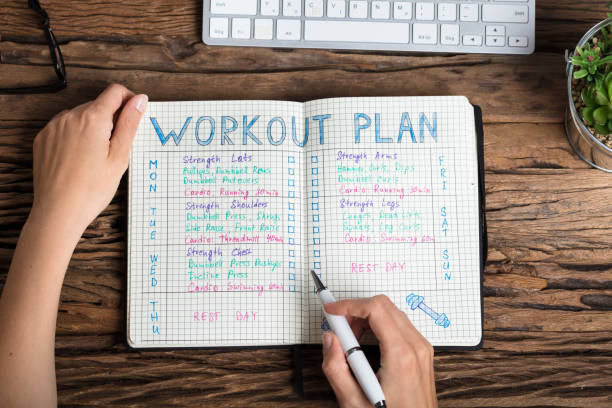Creating an effective workout routine is essential for achieving your fitness goals, whether you’re looking to build muscle, lose fat, or improve overall health. Workout routines are structured plans designed to target specific fitness objectives by balancing different types of exercises. Here’s a comprehensive guide on how to craft the perfect workout routine that suits your lifestyle, experience level, and goals.
Understanding the Importance of Workout Routines
A well-structured workout routine can make the difference between seeing great results and plateauing. Consistency is key when it comes to fitness, and having a routine helps ensure that you stay on track. A routine helps prevent overtraining, reduces injury risks, and ensures you target all areas of your body effectively.
Components of a Well-Rounded Workout Routine
For a balanced approach, your workout routine should include these core elements:
Warm-Up and Stretching
The warm-up is often overlooked but is critical for preventing injuries. Spending 5-10 minutes on light cardio exercises like jogging or jumping jacks increases blood flow to the muscles, preparing them for more intense activity. Follow this with dynamic stretches that mimic the movements in your workout to increase flexibility and reduce the risk of injury.
Strength Training
It takes strength training to develop and maintain muscle mass. Incorporate exercises that target all major muscle groups, such as squats, lunges, bench presses, and deadlifts. If you’re a beginner, start with bodyweight exercises like push-ups and squats, gradually progressing to lifting weights as your strength improves.
Sample Strength Training Plan:
Monday: Upper Body (push-ups, shoulder press, dumbbell rows)
Wednesday: Lower Body (squats, lunges, leg press)
Friday: Full Body (deadlifts, pull-ups, kettlebell swings)
Cardio Exercises
Cardiovascular exercises like running, cycling, or swimming are essential for improving heart health and burning calories. Depending on your goals, cardio can be tailored to burn fat or boost endurance.
Types of Cardio:
Steady-State Cardio: Running or biking at a consistent pace for 30-60 minutes. This is excellent for endurance.
High-Intensity Interval Training (HIIT): Quick recovery intervals are interspersed with brief bursts of intensive exertion. This is ideal for fat loss and improving athletic performance in less time.
Sample Cardio Routine:
30 minutes of cycling on Tuesday and Thursday
20-minute HIIT session on Saturday
Core Strength and Stability
Workout training helps stabilize the body, improving overall strength and preventing injuries, especially in the lower back. exercises like planks, Russian twists, and leg raises should be part of every workout routine.
Sample Core Routine:
Planks (3 sets of 30-60 seconds)
Russian Twists 3 sets of 15–20 repetitions on each side
Bicycle Crunches (3 sets of 20 reps)
Flexibility and Mobility Training
Flexibility and mobility are often overlooked but are crucial for maintaining a full range of motion in the joints. This can prevent muscle tightness and improve workout performance. Yoga or stretching routines should be done at least 2-3 times a week.
Sample Flexibility Routine:
Stretching after each workout session
Yoga on Sunday for active recovery
Also Read: Importance of Relaxation in a Weight Loss Journey
Designing a Weekly Workout Routine
When crafting your workout routine, it’s important to strike a balance between strength, cardio, and flexibility while allowing adequate recovery time. Here’s an illustration of a well-rounded weekly schedule:
Monday: Upper body strength training + core exercises
Tuesday: Cardio (steady-state or HIIT)
Wednesday: Lower body strength training + core exercises
Thursday: Cardio (steady-state or HIIT)
Friday: Full-body strength training
Saturday: Cardio + flexibility training (yoga or stretching)
Sunday: Take it easy or work on getting better. (yoga or mild walking)
Adjusting Your Routine Based on Goals
For Muscle Gain:
Focus more on strength training, increasing the number of sets and weight. Reduce cardio sessions to avoid burning too many calories. Make sure to progressively increase the weights to challenge your muscles.
For Fat Loss:
Cardio should take center stage, particularly HIIT, as it’s efficient for burning fat. Combine this with moderate strength training to maintain muscle mass. Aim for 3-4 cardio sessions per week, paired with strength training.
For Endurance:
Focus on steady-state cardio exercises and long-duration activities like running or cycling. Strength training should include higher repetitions and lighter weights to improve muscular endurance.
Recovery: The Missing Piece in Workout Routines
The recuperation process is just as important as exercise. Your muscles need time to repair and grow stronger, so always allow for rest days. As overtraining can result in burnout and injuries, pay attention to your body. Incorporate foam rolling, massages, or light stretching to help speed up recovery.
Tips for Staying Consistent with Your Workout Routine
Set Clear Goals: Having a goal, whether it’s losing weight, gaining muscle, or running a marathon, will help you stay motivated and committed to your routine.
Track Progress: Keep a workout journal or use fitness apps to monitor your improvements in strength, endurance, or weight loss.
Make It Enjoyable: Choose exercises you enjoy to make your routine something you look forward to rather than dread.
Get a Workout Buddy: Having a partner can boost motivation and accountability.
Conclusion
Building an effective workout routines is about finding the right balance between strength training, cardio, flexibility, and recovery. By focusing on each of these components and tailoring your routine to your specific goals, you’ll be able to achieve better fitness results. Recall that perseverance and commitment are the secrets of success.





